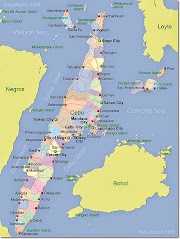CEBU CITY -- Part of a farm in Barangay Camboang, Dumanjug town collapsed, creating a big sinkhole, which authorities believe was caused by the earthquake that struck Central Visayas nearly two weeks ago.
Senior Police Officer 1 Joselito Abella said the hole has a diameter of about eight meters and was six meters deep as of 4 p.m. Friday. The soil was still eroding.
Less than 12 hours earlier, the hole was smaller but deeper when farm caretaker Walter Pesalbon first saw it in the 2.7-hectare farm. He said it looked no wider than a big cauldron.
Dumanjug Mayor Nelson Garcia told reporters he had ordered the police and barangay watchmen to guard the area and make sure people aren’t allowed inside the fenced farm.
Garcia, who visited the site, said he expects the sinkhole will be bigger next week. Aftershocks could have caused the sinkhole, he said.
He said the Mines and Geosciences Bureau (MGB)-Central Visayas will inspect the area on Monday. They couldn’t do it sooner because most of the geologists were deployed to Negros Oriental, where several landslides occurred after the 6.9-magnitude earthquake last February 6.
“There is a possibility that there is a cave below the farm,” said Garcia in Cebuano.
Farm caretaker Pesalbon said he woke up early Friday and visited the farm. As he was walking toward his house around 5 a.m., he felt the soil tremble.
Pesalbon, 36, said he heard an explosion and when he turned around, he saw part of an eggplant garden collapsed. He also noticed rushing water below the sinkhole, which was only as big as a cauldron.
Bigger
He ran toward his home nearby and informed his neighbor, Jeramara Fernandez, whose house is about 20 to 25 meters away from Pesalbon’s.
Within hours, Pesalbon saw the hole get bigger and bigger, at one point swallowing a 14-foot electrical post. But the hole also became shallower.
The caretaker said the soil in the farm, owned by a Swedish national who married a Cebuana, became soft after a week of incessant rain.
The lot is five meters from barangay road and one kilometer from the national highway, said Camboang barangay chief Jojo Quirante.
Last Thursday afternoon, Pesalbon said the soil collapsed a bit during an aftershock. Later that night, resident Fernandez, 44, said she noticed the earth shook before the rain.
“Abi nakog sakyanan ang niagi (I thought a vehicle passed by our house),” she said.
Pesalbon, who has worked in the farm for three years, said it was the first time a sinkhole showed up in the property, which his family used to own.
“Wa man tay mahimo ana (There’s nothing I can do about it),” he said. “Pagbuot man na sa Ginoo (It’s God’s will).”
Limestone
The sinkhole is located roughly three kilometers from the municipal hall.
In a press statement, the MGB-Central Visayas said it received information from the Regional Disaster Risk Reduction and Management Council that the sinkhole was newly formed within a private property of a certain Joy Distelkamps.
MGB information officer Dr. Eddie Llamedo said the sinkhole can be formed through the gradual removal of slightly soluble bedrock, such as limestone, by percolating water, the collapse of a cave roof, or a lowering of a water table.
“This is part of the karst processes or chemical dissolution of carbonate rocks,” he said.
“Approximately 70 percent of the total land area of Cebu is covered by limestone materials, and sinkholes are common where the rock below the land surface is limestone. As limestone rock dissolves, spaces and caverns develop underground,” he added.
Based on the rapid geohazard assessment on rain-induced landslides and flooding in 2009, MGB-Central Visayas geologists observed the presence of sinkholes in 14 barangays in Cebu Province.
Dumanjug was among the towns mentioned.
Warning
Sinkholes were found in 11 barangays in Tuburan, namely: Bulwang, Lusong, Montealegre, Santo Niño, Siotes, Kabkaban, Libo, Taminjiao, Kalangahan, Bagasawe, and Sandayong.
They were also spotted in Barangays Linut-od in Argao, Kang-actol in Dumanjug, and Vive in Ronda, Cebu. (A large fissure was reported in a mountain in Vive, Ronda after the recent earthquake.)
A sinkhole, also known as a sink, shake hole, swallow hole, swallet, doline or cenote, is a natural depression or hole in the surface topography caused by karst processes -- the chemical dissolution of carbonate rocks.
MGB-Central Visayas Director Loreto B. Alburo said Senior Science Research Specialist Abraham R. Lucero Jr. will check the area.
Based on the initial account, the collapse or cave-in of the cave roof, which resulted in the formation of a sinkhole, may have been trigged by the 6.9-magnitude earthquake and many aftershocks, and intense and prolonged rain. The earthquake may have caused ground or tension cracks, and these factors may have weakened the cave roof.
As a precautionary measure, Alburo initially recommended the installation of a fence, proper warnings or signs, and continuous monitoring by the local government. (from Sun.Star Cebu)
Translate
Subscribe Us
Most Popular
Search This Blog
Beauty of Cebu - Discover and be discover the best places here at the Queen City of the South
Tel: +63
Email: beautyofcebu@gmail.com
Popular Posts
Discover Philippines Best Travel Destinations, Adventure Spots, Cities, Resorts and Beaches
Ad Code
Contact Form
Footer Menu Widget
Copyright by Beauty of Cebu | By Beauty of Cebu









1 Comments
Hi friends, fastidious article and fastidious arguments
ReplyDeletecommented here, I am actually enjoying by these.
my webpage: moving company cost Jersey City